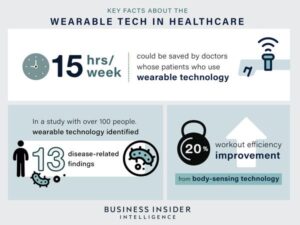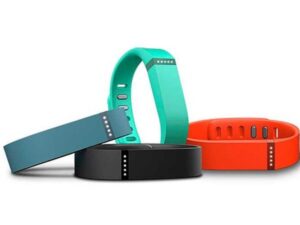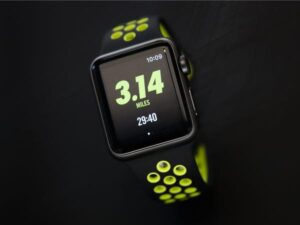Wearable fitness technology has weaved itself into society so that FitBits and smartwatches are seen as mainstream; and the future of wearable devices shows no sign of slowing down.

Piloted by the increasing demand of consumers to monitor their own health, use of wearable technology has more than tripled in the last four years. According to research from Business Insider Intelligence, more than 80% of consumers are willing to wear fitness technology.
This growing demand for wearables has generated a booming market, and now insurers and companies are seeing how supplying wearable health technology to their consumers and employees is beneficial.
What is wearable healthcare technology?
Wearable technology in healthcare includes electronic devices that consumers can wear, like Fitbits and smartwatches, and are designed to collect the data of users’ personal health and exercise. US consumer use of wearables jumped from 9% in 2014 to 33% in 2018, according to Accenture.
Examples of Wearable Devices in Healthcare
The advancement of wearable technology and growing demand from consumers to take control of their own health has influenced the medical industry, including insurers, providers, and technology companies, to develop more wearable devices such as Fitbits, smartwatches, and wearable monitors.
Wearable Fitness Trackers
Some of the simplest and most original forms of wearable technology, wearable fitness trackers, are wristbands equipped with sensors to keep track of the user’s physical activity and heart rate. They provide wearers with health and fitness recommendations by syncing to various smartphone apps.

Photo Credit: Courtesy of Fitbit® Flex™
The Fitbit Flex was an early, popular option for wearable technology consumers. Users were attracted to its sleek look and ability to track their step progress throughout the day with the device’s five indicator lights.
Smart Health Watches
Once only used to count steps and tell time, smartwatches have now transformed into clinically viable healthcare tools. Apple launched the Apple Heart Study app in 2017 to monitor users’ heart rhythms and alert those who are experiencing atrial fibrillation.

The company also recently released the “Movement Disorder API” to help researchers gather new insights into Parkinson’s disease.
Smartwatches allow users to perform tasks they normally do on their phones — read notifications, send simple messages, make phone calls — while also offering some of the exercise- and health-tracking benefits of fitness trackers.
Wearable ECG Monitors

Wearable ECG monitors are on the cutting edge of consumer electronics, and what sets these monitors apart from some smartwatches, is their ability to measure electrocardiograms or ECGs. Business Insider recently reported on Withings winning best wearable at the 2019 Consumer Electronics Show with their Move ECG product.
The Move ECG is able to measure an electrocardiogram and send the reading to the user’s doctor, as well as detect atrial fibrillation. It’s also able to track pace, distance, and elevation, as well as automatic tracking for walking, running, swimming, and biking.
Wearable Blood Pressure Monitors
Omron Healthcare launched HeartGuide in 2019, the first wearable blood pressure monitor. Though it might look like a typical smartwatch, HeartGuide is an oscillometric blood pressure monitor that can measure blood pressure and daily activity – like steps taken, distance traveled, and calories burned.
HeartGuide can hold up to 100 readings in memory and all readings can be transferred to a corresponding mobile app, HeartAdvisor, for review, comparison, and treatment optimization. HeartAdvisor users have the ability to store, track, and share their data with their physician while also gaining insights to determine how personal habits affect their blood pressure.
Biosensors
Biosensors are up and coming wearable medical devices that are radically different from wrist trackers and smartwatches. The Philips’ wearable biosensor is a self-adhesive patch that allows patients to move around while collecting data on their movement, heart rate, respiratory rate, and temperature.
Research from Augusta University Medical Center showed that this wearable device registered an 89% reduction in patient deterioration into preventable cardiac or respiratory arrest. This demonstrates the ability wearables have to improve patient outcomes and possibly reduce staff workload.
Advances in & future of medical devices
The wearable healthcare technology market is surging, and its maturation will put more wearable technology in the hands of consumers and US businesses. According to Business Insider Intelligence research, the total installed base of fitness tracker and health-based wearables in the US will grow at an annualized rate of 10% to surpass 120 million by 2023.
This upward trend in wearable fitness technology will influence the decision of insurers, health providers, and companies to take advantage of the benefits of wearable health monitoring devices.
Insurers can lessen the rising cost per patient by using wearables as a means of increasing customer life value. Wearable technology incentivizes behavior that reduces hospital visits and readmissions due to poorly managed personal health – 75% of users agree that wearables help them engage with their own health.
Companies are also seeing benefits in offering wearable healthcare technology to employees. According to Business Insider Intelligence research, healthier corporate culture is shown to reduce employee turnover – employers who offer five or more well-being ‘best practices’ had an average turnover of 18%, compared to 29% for those that offer two or fewer.
US consumer use of wearables increased from 9% to 33% in just four years, and this number will continue to grow as wearable technology becomes more conventional. Moreover, device connectivity will expand as more accurate wearable sensors are developed, opening the door for insurers and employers to influence healthy lifestyles and boost profitability.
Interested in more related Digital Health research?
In addition to wearable tech coverage, Insider Intelligence publishes a wealth of research reports, charts, forecasts, and analysis of the Digital Health industry. You can learn more about accessing all of this content here.
And here are some related Digital Health reports that might interest you:
- The Digital Health Ecosystem, which explores the key trends driving digital transformation in healthcare and what we expect to see in the year ahead.
- Big Tech in Healthcare, which looks at how Alphabet, Amazon, Apple, and Microsoft are moving into the healthcare space.
- The Digital Therapeutics Explainer, which explores the drivers lighting a fire under the DTx market, identifies the leading DTx market players and unpacks the varied ways vendors reach their intended audiences.